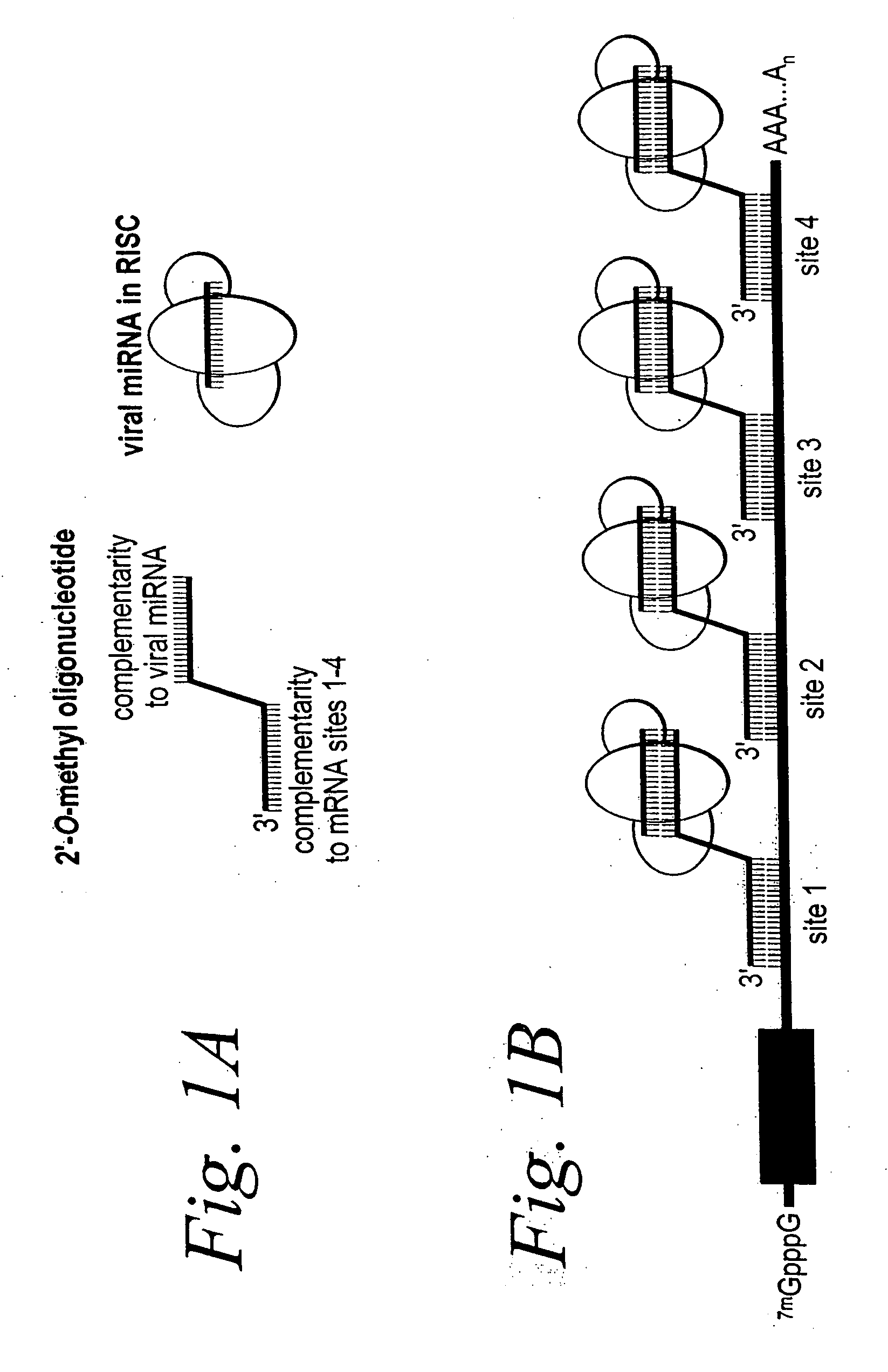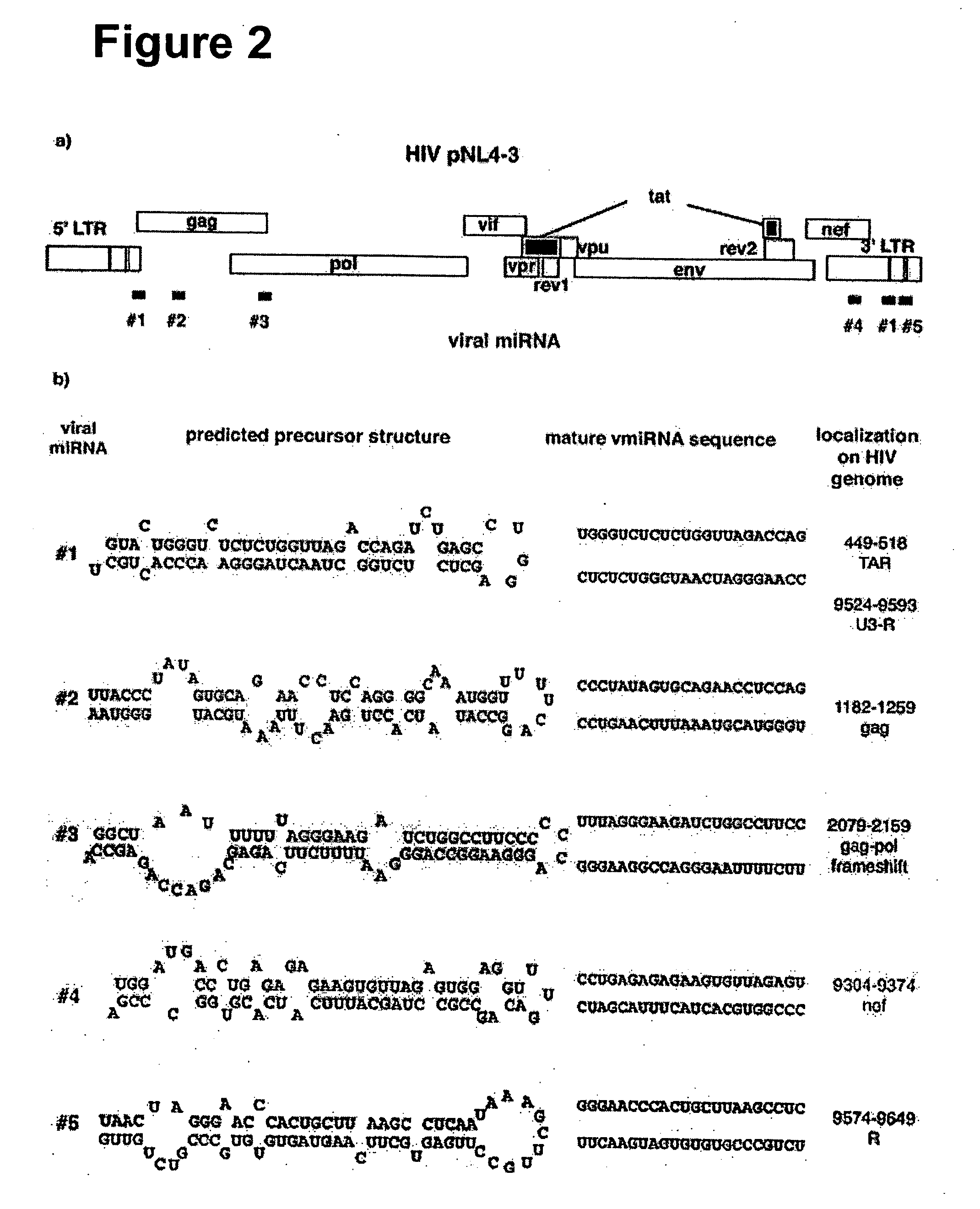Dual functional oligonucleotides for use as anti-viral agents
a functional oligonucleotide and antiviral technology, applied in the direction of viruses/bacteriophages, organic chemistry, genetic material ingredients, etc., can solve the problem of unclear role played by viral mirnas in infectious diseases, and achieve the effect of increasing the in vivo stability of the agen
- Summary
- Abstract
- Description
- Claims
- Application Information
AI Technical Summary
Benefits of technology
Problems solved by technology
Method used
Image
Examples
example 1
Probing HIV miRNA as an Effector in RNA Silencing
[0225] In the instant example, a synthetic HIV miRNA is recruited to a target mRNA using a 2′-O-methyl oligonucleotide complementary to both the HIV miRNA and the mRNA target. 2′-O-methyl oligonucleotides have been shown to be irreversible, stoichiometric inhibitors of miRNA function (Hutvagner et al. (2004) PLOS Biology, in press). The method recruits the viral miRNA-programmed RISC to the target mRNA to prevent translation of the target mRNA.
[0226]FIG. 1 depicts interactions between the designed 2′-O-methyl oligonucleotide and a viral miRNA. FIG. 1 further depicts the general design of an embodiment of the 2′-O-methyl oligonucleotide appropriate for the present example. The 3′ end of the oligonucleotide is designed to bind to an mRNA. The 5′ end of the oligonucleotide is complementary to the sequence of a viral miRNA, in this case HIV-miR-GAG / POL-1 or HIV-miR-GAG / POL-2. The diagram shows four sites of oligonucleotide complementari...
example 2
Recruiting Expressed HIV miRNAs in an HIV Infected Host Cell for Gene Silencing
[0231] In the instant example, a viral miRNA expressed in HIV infected cells is recruited to effect silencing of an mRNA that is essential for HIV infection or replication. The method employs oligonucleotides comprising sequences that are complementary to both an HIV miRNA and an mRNA target sequence expressed by the host cell or HIV.
[0232] For the present example, oligonucleotides are synthesized with two functional domains: a domain complementary to HIV-miR-GAG / POL-1 or HIV-miR-GAG / POL-2 miRNA, and an oligonucleotide region complementary to an mRNA sequence expressed by the virus (e.g. HIV protease) or the infected cell (e.g. the host cell chemokine receptor CCR5). Oligonucleotides can be designed to test silencing of any mRNA encoded by the HIV genome or any mRNA required by the HIV virus during its replication cycle.
[0233] In the present example, each oligonucleotide is transfected into CD4+ human ...
example 3
Effectiveness of a Dual-Functional Oligonucleotide in Inhibiting HIV Infection of Human Cells
[0234] In the instant example, dual-functional oligonucleotides are tested for their effectiveness in inhibiting the infection of human cells by HIV, thereby reducing the viral load of the infected cell. The dual-functional oligonucleotides are complementary to an HIV miRNA (e.g. HIV-miR-GAG / POL-1 or HIV-miR-GAG / POL-2 miRNA) and a host cell mRNA (e.g. CCR5) necessary for the entry of the virus into the host cell.
[0235] In the present example, CD4+ human astroglioma U87 cells are stably co-transfected with CCR5 and CXCR4, washed, and resuspended at 5×104 cells / ml in medium and seeded out in 24 well plates (see Princen et al., Retrovirology, (2004), 1:2). Cells are infected with a low concentration (e.g. 1-10 pg / ml) of a laboratory strain of HIV-1 (e.g., the T-Tropic (X4) HIV-1 molecular clone NL4.3, National Institute of Allergy and Infectious Disease AIDS Reagent program, Bethesda, Md.). T...
PUM
| Property | Measurement | Unit |
|---|---|---|
| Pharmaceutically acceptable | aaaaa | aaaaa |
| Gene expression profile | aaaaa | aaaaa |
| Stability | aaaaa | aaaaa |
Abstract
Description
Claims
Application Information
 Login to View More
Login to View More - R&D
- Intellectual Property
- Life Sciences
- Materials
- Tech Scout
- Unparalleled Data Quality
- Higher Quality Content
- 60% Fewer Hallucinations
Browse by: Latest US Patents, China's latest patents, Technical Efficacy Thesaurus, Application Domain, Technology Topic, Popular Technical Reports.
© 2025 PatSnap. All rights reserved.Legal|Privacy policy|Modern Slavery Act Transparency Statement|Sitemap|About US| Contact US: help@patsnap.com


